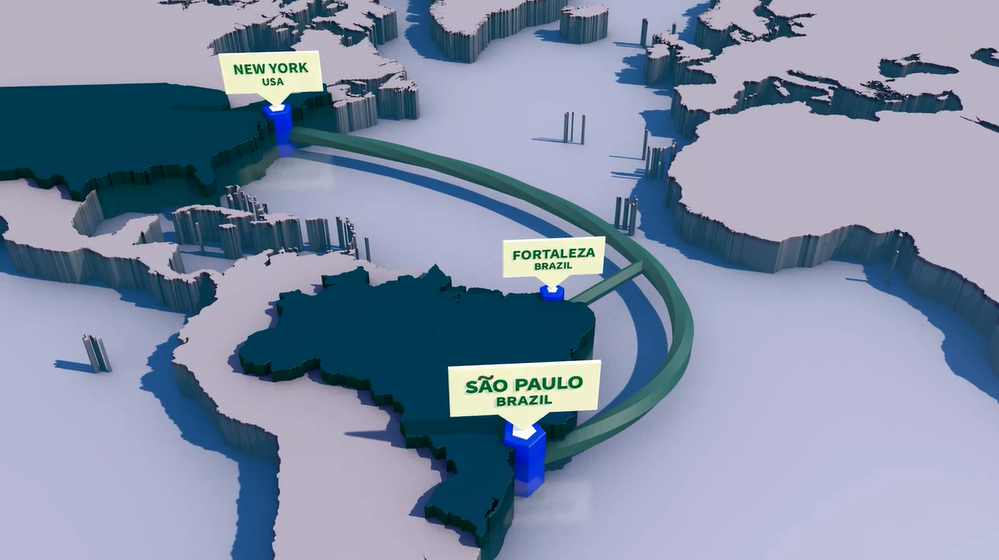|
Seaborn Networks, a leading developer-owner-operator of submarine fiber optic cable systems, announced today that its Seabras-1 subsea cable system is ready for operations. Seaborn’s Seabras-1 is a new 6-fiber pair, 72 Tbit/s submarine cable system that is the first and only direct point-to-point system between São Paulo, Brazil and New York, USA. Seabras-1 Cable Map Source: Seaborn Networks
Seabras-1 is owned jointly by Seaborn Networks and Partners Group (a global private markets investment manager with USD 66 billion in assets under management) on behalf of its clients. Seaborn operates and maintains Seabras-1 from its offices in the United States and Brazil, including Seaborn’s own dedicated network operations centers in New Jersey and Massachusetts. Seabras-1 offers a faster and more reliable carrier class route between the commercial centers of Brazil and the US than competing systems, with improved quality of service, a more resilient network architecture and 100% underground terrestrial backhaul in Brazil. By purchasing directly from Seaborn, customers also benefit from the ability to communicate directly with the owner-operator of the system, industry-leading turnarounds for circuit activation and unique purchasing platforms. Seaborn’s proprietary SeaSpeed™ solution to the financial vertical will commence service in Q4 2017. SeaSpeed is the lowest latency route between the trading exchanges of New Jersey and São Paulo (B3/BM&FBovespa), with dedicated capacity from B3 (SPA) in São Paulo to Carteret and onward to your choice of New York or New Jersey points of presence. Source: Seaborn Networks Press Release ANALYSIS: It is exactly five years since Seaborn Networks signed a turnkey supply contract with Alcatel for the Seabras-1 submarine cable system. Add to this the probable two years of planning before that for an unusually long development and implementation time line. There were two key issues which contributed to elongation of the process. First, as a private company, Seaborn Networks, headed by Larry Schwartz, former CFO of now defunct CLEC, Genuity, had to find US$353M plus working capital to fund the project. Schwartz is well-connected within the U.S. financial community but it took three years for him to put together a deal with Partners Group yielding US$110M in equity. A year later, Seaborn Networks announced a debt package of US$265M with Natixis, Banco Santander, Commerzbank and Intesa Sanpaolo, guaranteed by the French Export Credit Agency, COFACE. With support from Microsoft, Facebook, and Tata Communications, Seaborn Networks achieved IRU pre-sales of over US$200M. But the most remarkable aspect of the pre-RFS funding was a deal done with Telecom Italia Sparkle in January 2016 for three out of the six fibre pairs at a price of US$300M. This deal is still talked about in the market with many people scratching their heads over TI Sparkle’s strategic intent and rumors of discontent with the deal coming from the Company’s senior management. On the other hand, from Seaborn’s point of view, offloading three of the six fibers was a tipping point for the Seabras-1 project. The other factor which contributed to the long gestation period of this project was the nature of the business environment in Brazil. Seaborn acquired land and built its own landing station at Praia Grande, Santos, Brazil. They also managed to obtain redundant underground dark fiber backhaul routes to their PoP in São Paulo, Brazil in a market renowned for its oligopolistic nature. In addition to negotiating these commercial deals, the permitting process in Brazil also took up a lot of time. Seabras-1 is a remarkable achievement for Seaborn Networks but the work is not yet over. Over the seven years it has taken to bring the cable into operation the market for wholesale connectivity between Brazil and the U.S. has become extremely competitive with new cables introduced by Telefónica, Google, and América Móvil reducing the size of the addressable market for Seabras-1 and the other much older private cable operator, GlobeNet. In response, Seaborn has sought to differentiate Seabras in terms of lower latency between financial centers, greater resiliency in the Brazilian backhaul, and “purchasing platforms”. Seaborn’s proprietary “SeaSpeed” solution is focused on the financial sector while a strategic deal with Megaport has given Seaborn access to an “out-of-the-box software platform that allows customers to order and provision elastic services via an online portal”. Seaborn has also interconnected in New York with the private transatlantic cable, AE Connect, to provide seamless connectivity from Brazil to Europe and the Company is now working on an extension of Seabras-1 from Brazil to Argentina. These efforts by Seaborn to differentiate their service are commendable and right-headed because wholesale pricing on the Latin America-North America route is falling rapidly and is likely eventually to come close to transatlantic pricing which is the most competitive and transparent in the world. If Seaborn’s customers start to feel that the pre-RFS deals no longer look that attractive, they make want to re-negotiate.
0 Comments
Leave a Reply. |
Julian Rawle, AuthorThought leadership articles and commentary on developments related to the subsea fibre optic cable industry can be found here. Archives
February 2018
Categories |




 RSS Feed
RSS Feed